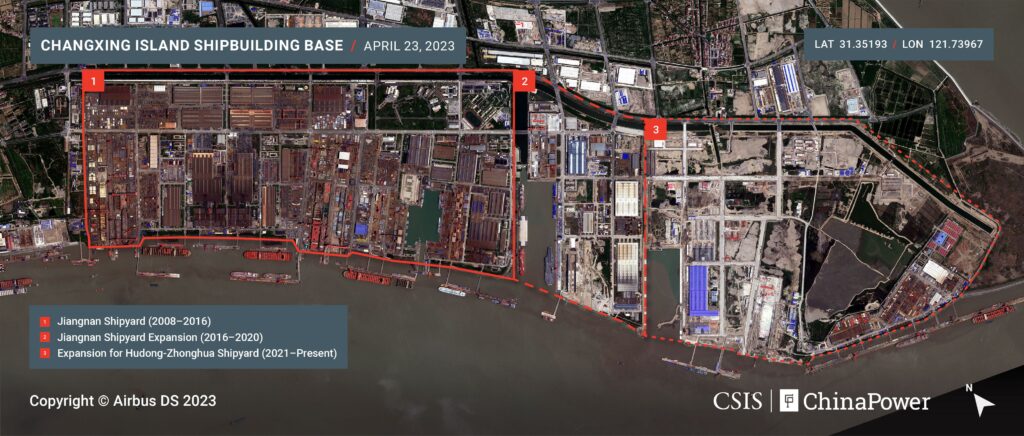By Matthew P. Funaiole, Brian Hart, Joseph S. Bermudez Jr., Jennifer Jun, and Samantha Lu
May 18, 2023
As part of China’s ongoing efforts to modernize the People’s Liberation Army Navy (PLAN), work is currently underway to transform Shanghai’s Changxing Island into a colossal “shipbuilding base.” Recent commercial satellite imagery shows that the island’s already-impressive shipbuilding facilities are being rapidly expanded.
For over a decade, Changxing Island has been home to Jiangnan Shipyard, which has built many of the PLAN’s most advanced warships, including China’s third aircraft carrier and much of its fleet of Type 055 and Type 052 destroyers. The expansion of facilities there will solidify Changxing Island as the epicenter of China’s shipbuilding empire.
Phase One: Relocating Jiangnan Shipyard
Changxing Island’s transformation into a shipbuilding base began nearly two decades ago. In 2005, an ambitious endeavor kicked off to move Jiangnan Shipyard from its existing facilities in central Shanghai to a new site on the southern end of Changxing Island. The state-owned China State Shipbuilding Corporation (CSSC), which owns Jiangnan Shipyard, announced the completion of the move in 2008 and hailed it as “phase one” of the CSSC Changxing Island Shipbuilding Base.1
The scale of Jiangnan’s new facilities was immense. It covered an area of 5.6 square kilometers (km) and contained roughly 1.1 million square meters of ship construction facilities. The project was reportedly completed at a cost of RMB 16 billion, or about $2.3 billion in 2008.
That, however, was only the beginning for the reimagined Jiangnan Shipyard. From 2016 to 2020, the shipyard was expanded by nearly one-third. The new portion included a massive man-made basin, new fabrication halls, and a new fabrication and assembly area where early stages of the third aircraft carrier’s construction occurred.
Click to enlarge.
Phase Two: Relocating Hudong-Zhonghua Shipyard
Work is currently underway on another major expansion on Changxing, which marks phase two of CSSC’s transformation of the island. This project will see the relocation of another key shipyard, Hudong-Zhonghua, from central Shanghai to the area directly adjacent to Jiangnan. Hudong-Zhonghua has produced several of the PLAN’s largest surface combatants, including three Type 075 amphibious assault vessels and eight Type 071 amphibious transport dock ships. It has also constructed numerous Type 054 frigates for the PLAN and for the Pakistan navy.
CSSC broke ground on the project on January 4, 2021, and the project is planned to unfold in two steps. The first step covers some 2.1 square km and includes a new dry dock for assembling large vessels as well as a new basin where vessels will be moored and fitted out. The second step is expected to bring online additional fabrication and assembly facilities.
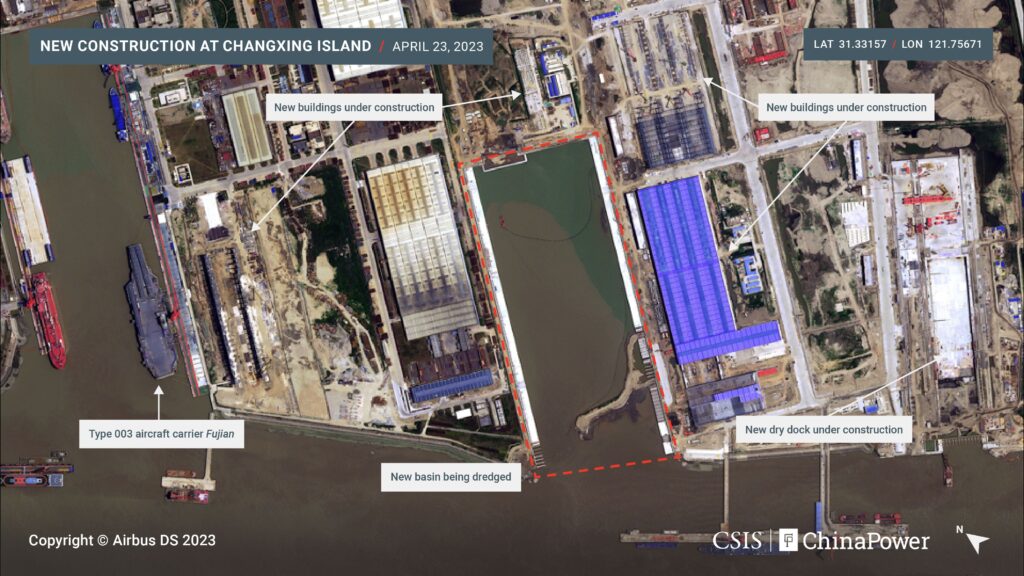
Reports indicate that workers poured the base of the new dry dock in October 2022, and satellite imagery from April 23, 2023, shows that considerable progress has been made since then. The dry dock is now clearly defined and measures approximately 650 meters long by 94 meters wide, which is slightly larger in area than the largest dry dock in the main area of Jiangnan Shipyard.
The April 23 satellite imagery also shows that rapid progress has been made on dredging the new basin. In January, the basin remained largely filled in with earth, but by April it was almost entirely covered by water. The new basin measures approximately 760 meters by 280 meters, making it about three-quarters of the size of the large main basin that was added to Jiangnan in recent years (which measures 930 meters by 300 meters).


This first part of the expansion is scheduled to be completed by the end of 2023, and progress to date indicates that timeline is feasible. No timeline has yet been given for the overall completion of the expansion.
Once completed, the new facilities will reportedly include 5G network technology, big data management, and robotic welding, with the goal of transforming the relocated Hudong-Zhonghua into a “digital shipbuilding enterprise” capable of automated manufacturing and intelligent design. When the project wraps, Hudong-Zhonghua’s old facilities in central Shanghai will be transformed into a waterfront tourist attraction promoting culture and history.

The relocation of Hudong-Zhonghua to Changxing Island constitutes a massive investment in deepening China’s shipbuilding prowess. It is slated to come with a price tag of roughly $2.6 billion, and the new area will encompass some 4.3 square km—about 58 percent of the size of the existing facilities at Jiangnan.2 In all, the combined Changxing Island Shipbuilding Base will stretch nearly 7.7 kilometers end-to-end and cover an area over twice the size of Midtown Manhattan.
This undertaking will also concentrate an immense portion of China’s shipbuilding capacity into one area. On top of producing warships, both shipyards produce an impressive number of commercial vessels. Available data shows that Hudong-Zhonghua is scheduled to deliver at least 10 commercial vessels this year alone, including eight container ships, a liquified natural gas (LNG) carrier, and a multipurpose vessel.
Jiangnan’s order books are even fuller. It is scheduled to deliver a staggering 22 commercial vessels in 2023, including 14 liquified petroleum gas/ethane carriers, seven container ships, and one LNG carrier.
Key Shipbuilding Activity at Jiangnan
In addition to revealing details about the construction of new facilities, the April 23 satellite imagery provides key insights into some of the ongoing naval shipbuilding taking place there.
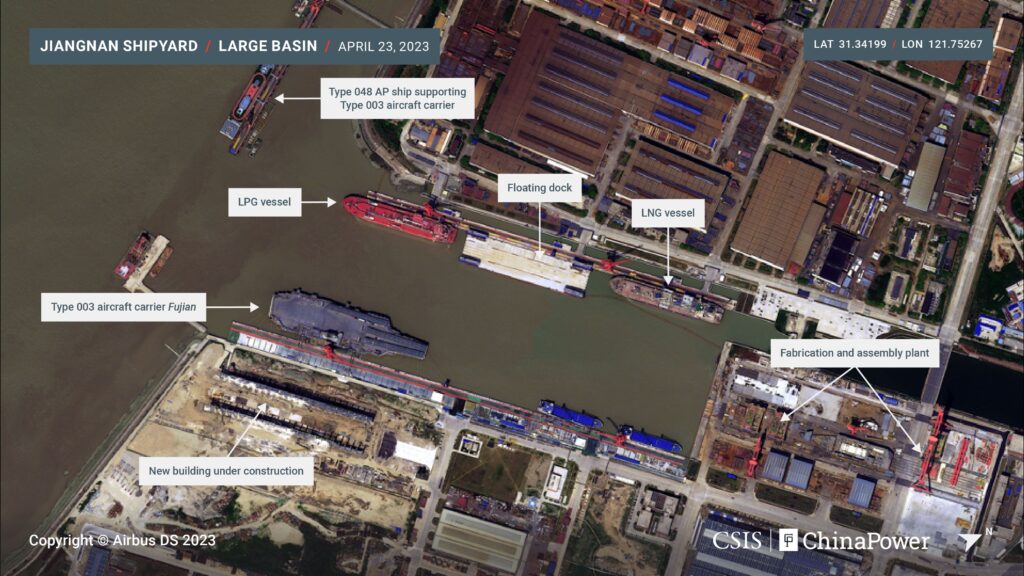
In the shipyard’s main large basin, work is underway outfitting the Fujian aircraft carrier, which was launched in June 2022. Satellite imagery shows that workers are installing the arrestor gear, which will capture aircraft as they land. Weapons and sensors are also being installed on sponsons at various points around the vessel. Notably, large environmental shelters still cover the deck’s three electromagnetic catapults that will launch aircraft, suggesting work on those is ongoing.
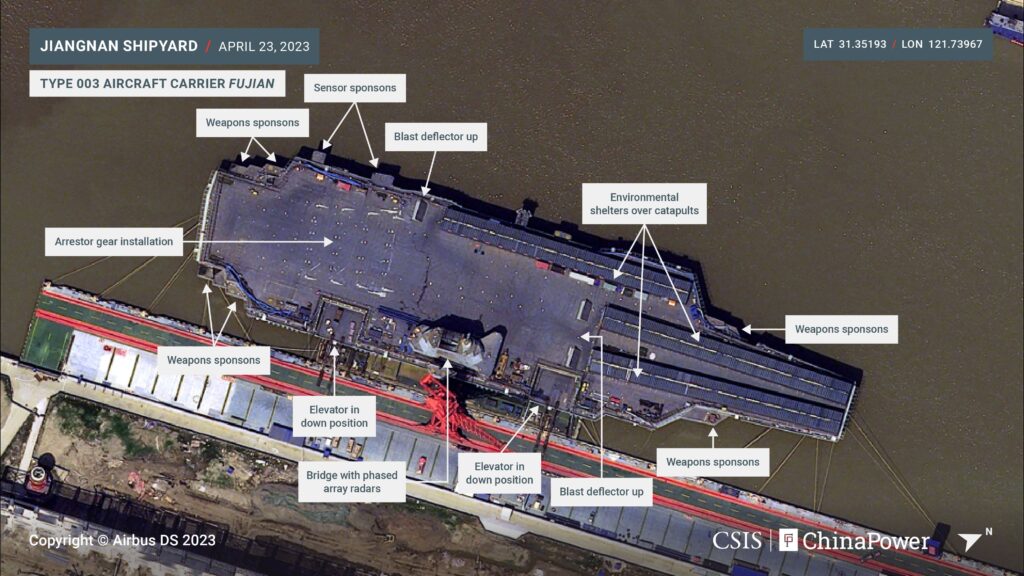
Click here to view a version of this image without labels.
Also visible near the large basin is a Type 048 auxiliary personnel ship (hull number 89). Also known as a troopship, this vessel supports workers involved in the fitting out and testing of the Fujian aircraft carrier. These ships are frequently spotted alongside China’s other aircraft carriers at their home ports. The Type 048’s arrival at Jiangnan in recent weeks suggests that the Fujian is likely to start sea trials in the coming months.
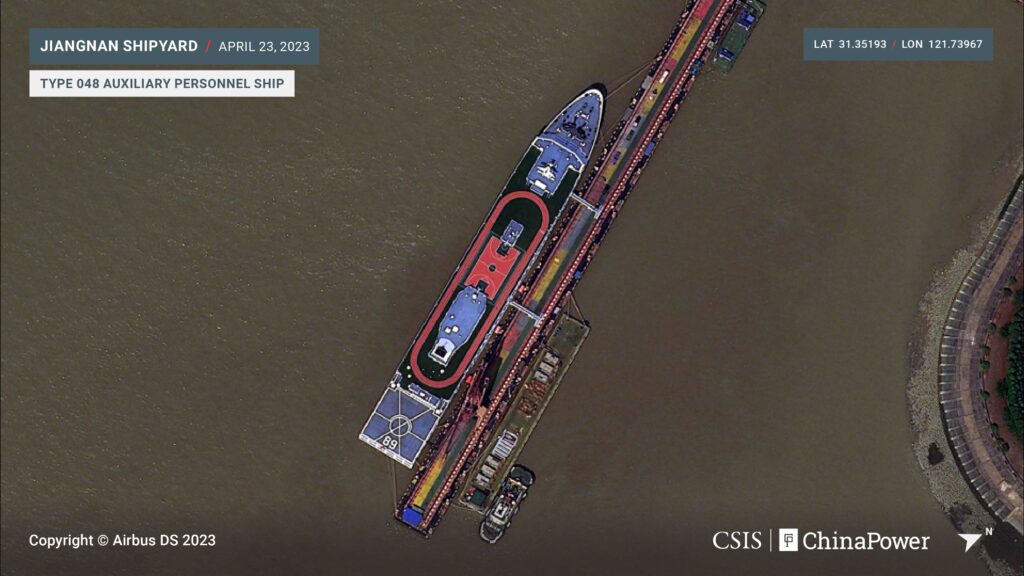
Nearby, three guided missile destroyers are being fitted out in Jiangnan’s smaller floodable basin, including two Type 052Ds and a Type 052C. Most interestingly, the April 23 satellite image provides a rare glimpse at the Type 052C’s vertical launch system (VLS). Each Type 052C is outfitted with eight VLS launchers (six forward and two aft), with each launcher containing six cells that house HHQ-9 naval surface-to-air missiles (which amounts to a total of 48 cells).3 Typically, the cells are covered by hatches, but this satellite image captured the outfitting process before the hatches were installed.
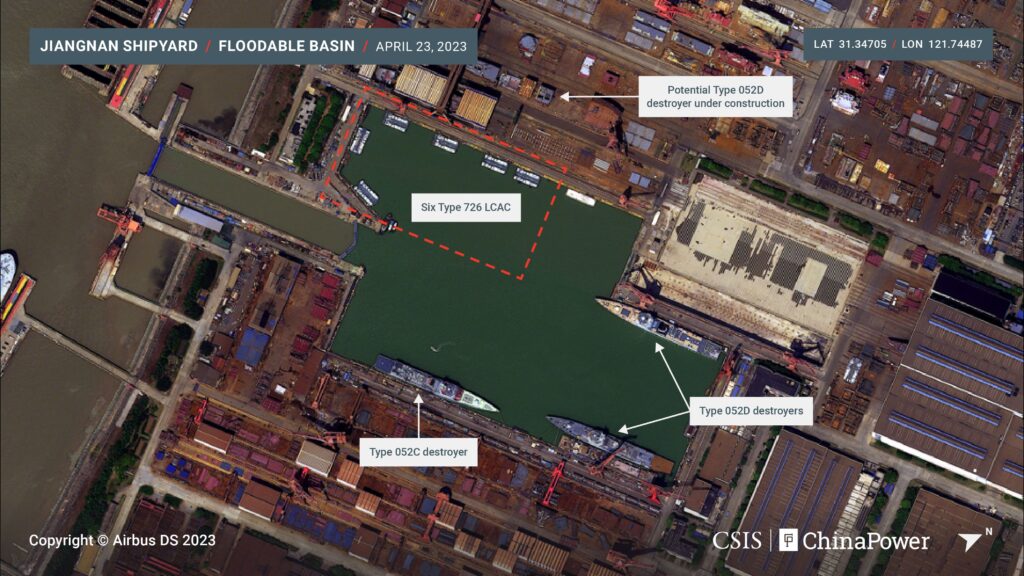

Taken together, activity at Jiangnan shows that China continues to make steady progress toward growing and modernizing the PLAN, and the expansion of facilities at Changxing Island confirms that China is investing in long-term capabilities to consolidate its position as a shipbuilding superpower. 
Note: This article originally referred to the Type 048 AP ship as the Xu Xiangqian. There is a Type 048 ship named Xu Xiake; however, that is hull number 88. The vessel shown in imagery on this page is hull number 89.

